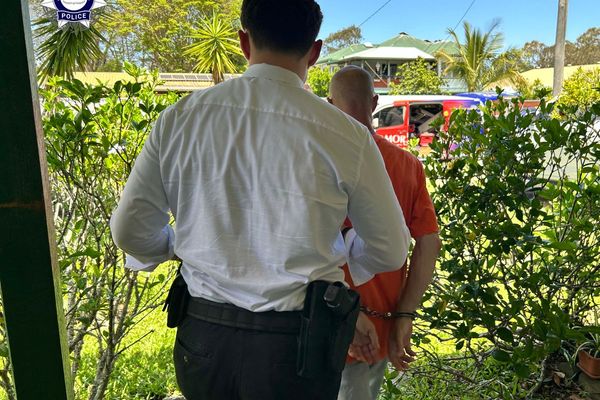
The latest album from Cage The Elephant was a long time coming. As lead guitarist Nick Bockrath says, “We started recording it three years ago!” But Neon Pill, the band’s first new record since 2019’s Social Cues, was worth waiting for.
Led by the Shultz brothers, singer Matt and rhythm guitarist Brad, Cage The Elephant have perpetrated some seriously radical indie-meets-garage-meets-psych-rock over the years. An expansive sound and boundary-pushing mindset has been evident from their self-titled debut from 2008, featuring the slinky blues-rocker Ain’t No Rest For The Wicked, and continued across albums such as 2013’s Melophobia, with its dreamy acoustic hit Cigarette Daydreams, and 2015’s Tell Me I’m Pretty, produced by The Black Keys’ Dan Auerbach.
The latter featured Nick Bockrath as an additional studio musician, but he graduated to full band member status for Social Cues, and his guitar hooks are slathered all over Neon Pill.
When Nick speaks to TG, the band are midway though a huge US tour, with close to 50 dates in major arenas. “This is really exciting,” he says. “It’s been almost five years since we’ve done a headline tour. It’s good to be back.”
As far as guitars go, what sounds were you searching for with this album?
“I’m always trying to react to what’s happening in the moment, but I’ve been listening to a lot of African music and amazing ’70s rock ’n’ roll. I got really into that stuff where the rhythm section is doing those African things, and the guitars are like the sound of Black Sabbath, like crazy fuzz. I’m always searching for off-the-beaten-path stuff.
“I also got really into psychedelic rock guitar, and I even got into Link Wray and Duane Eddy, who are classic examples of vibrato and the emotion they get from that. So my parts on the record were reactive to what I was hearing and influenced by.”
One of the great things about your playing – and it’s perfect for Cage the Elephant – is how you fill space within the layers of sound.
“I think of the guitar as a punctuation to the vocal. Whatever Matt is saying is the most important thing and the whole point of the song. It’s about, ‘How can I support that, and be like an exclamation point, or a comma, after his words?’ Sometimes a song will call for a cool‑sounding chord or a hooky riff.
“And sometimes, all those things happen and I don’t differentiate between the lead and the rhythm. I’m building throughout the song, but we as a band do lean toward having a hooky solo, where you can sing back the part. I think that kind of thing always wins over shredding, even though shredding is fun.”
Are there any keys to your tone?
“On this record, I really liked the Death By Audio Echo Dream 2 [delay pedal]. It’s kind of an echo pedal, but it’s got a fuzz built into it and a master volume. If you take the delay off or turn the fuzz down, it does something that is kind of like an always-on thing for me. I just love the tone of it.
“And I have this pedal from a guy who doesn’t make pedals anymore, a company called Pedal Projects. He made this pedal called a Growly, which is like a drive and a boost and has some compression. I always have it on and in front of my chain, and it’s essentially doing what a compressor would do.”
What sort of guitar amps do you find to be the best pedal platforms?
“Looking at the new album’s track listing, I think I used one amp on everything, which was a Fender Vibrolux. But we did some of the record at Electric Lady Studios, and they had a [Fender] Twin Reverb there, and I used that on a few tracks where it needed to be clean, but I wanted to crank it up and make the effects speak more.”
There was this one particular ’61 Les Paul Jr. – it was one of the sad-looking ones with just the one P-90, and I think it found its way onto every song
Were there other interesting gear discoveries at Electric Lady that took Neon Pill in an unexpected direction?
“I had my [Gibson] SG Custom from the ’70s. Well, the serial says: ‘70/71’. And I brought my pedal steel, too. There’s a song called Over Your Shoulder where I did a pedal steel overdub, and it was kind of cool because I don’t think there are a lot of people cutting pedal steel at Electric Lady in New York! It’s usually a Nashville thing.”
And the album was finished at Sonic Ranch studios in Texas.
“That was an amazing environment to be in. They had a great guitar collection there. We finished the record there, but there was this one particular ’61 Les Paul Jr. – it was one of the sad-looking ones with just the one P-90, and I think it found its way onto every song. I just completely fell in love with that guitar!”
Speaking of Over Your Shoulder, your pedal steel playing harnessed the emotion of that track perfectly.
“I really love that song. It was inspired by Matt and Brad’s father, who passed away. He was an amazing guy that we all loved, and he was a musician himself. That song has a beautiful, sentimental feeling to it, and there are some electric arpeggios that I play that I weave between the vocals in the chords to match Matt’s intensity. Matt’s dad loved pedal steel, so I thought that was a fitting vibe for him, and it supports the message of the song.”
I feel like Ball And Chain is cool for guitar stuff. There’s a really cool interplay between me and Brad, and the solo section I did was one I did when we were first writing it
You mentioned earlier that catchiness can’t help but win in Cage’s music. To that end, the riff from Rainbows sticks with you.
“That was one of the first songs we wrote, and it came together really fast. We spent a lot of time making the material for this record, but it was kind of cool to have that first one in the bag.
“That lead line was done during one of the first times we were all together after the pandemic, and it just felt amazing. I started humming part of the line, and then I came up with a call-and-response. When we shifted it around a bit, it turned into what it is, and it’s fun to play. That was one where I used that SG and my Maestro Fuzz. I love that tone.”
Is there one song on Neon Pill that best captures where you’re at now as a guitarist?
“That’s a hard one, but I feel like Ball And Chain is cool for guitar stuff. There’s a really cool interplay between me and Brad, and the solo section I did was one I did when we were first writing it, and it stuck until the end. It’s sort of like a Robert Fripp thing, like what he would play on a Talking Heads record. I really like that. I feel like there’s a cool, angular, rhythmic thing.”
Where will you take your playing next?
“I’m always just trying to grow and be able to play more styles of music. I’ll go through phases where I’m into country music, jazz, and Afrobeat, and I’m always blown away by really great rock riffs.
“So, I don’t know. I guess it keeps getting better. I’d maybe like to do an instrumental album one day. Before Cage, I used to do mostly improvisational music, so maybe getting back to that would be cool.”
Are there any techniques that you’re working on right now?
“I’m always working on being able to play stuff that I can incorporate into our songs. The best stuff always comes in and becomes natural to your playing. I’m playing a lot of jazz, and learning pedal steel has been really fun because it’s great for inspiration. You can always find something out in left field on the pedal steel, so that’s been great for me.
“If I’m looking for something new, I can always find it on pedal steel. I kind of have an innocence with it because with guitar, I’ve been playing since I was in the third grade. So, I just keep at it. It’s all I do. I play guitar, and I listen to music all day, honestly!”
Do you ever feel like you’re hitting a plateau, not advancing, or stuck in a rut? How do you get past that?
“Oh, totally. I mean, it sounds simple, but just keep the thing in your hands. Sometimes I try to learn something that’s not in my comfort zone, or something I want to work on, but it’s tough. Like, you can learn a tune, or a scale, or you can try to write it out as practice.
“And then there’s putting on a metronome and just recording yourself and hearing it back. But if you get stuck, it’s also good to go out and see other people you love playing music. I gain so much inspiration from just seeing a great show or listening to a great record. Going to shows is important.”
It also helps that you do some session work outside of Cage.
“I feel really lucky with that. It’s like a symbiotic thing for Cage, because I’m constantly getting inspiration from all over and coming up with parts for songs. It’s just like with practice. I’m not expecting a big eureka moment every time I practice, but sometimes my hands will just take me where I need to be. I’ll run a mindless scale, and it just comes.”
Beyond that, what’s your best piece of advice for readers?
“If you’re really bored with your playing, try to learn whatever you can play at half speed. It’s very humbling! And then work on your rhythm playing. I really think that there’s always something to learn, even if it doesn’t feel like a big thing. It can be learning a new chord or a riff. You might write something or a song 20 minutes later or figure out something you might not know. And that’s okay – either outcome is great!”
- Neon Pill is out now via RCA.







